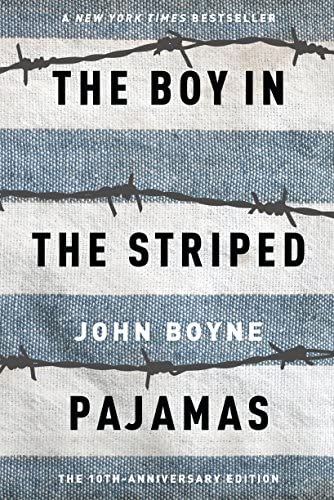
Seventeen years after its publication, John Boyne’s “The Boy in the Striped Pyjamas” has proven to be wildly successful; it’s a perennial bestseller with 11 million copies sold, has been translated into 57 languages, and has its own movie. However, in light of Holocaust Remembrance Day on January 27th, we must also consider its faults.
The novel has faced extensive criticism from the Jewish community and Holocaust scholars, most notably from the Auschwitz-Birkenau Holocaust Memorial Museum, for its incorrect portrayal of the Holocaust which has caused concern over the novel’s impact on Holocaust education in and out of the classroom.
The novel follows Bruno, a nine-year-old German boy who is the son of a high-ranking Nazi officer. His family, who, other than his father, are unaware of the horrors of the Holocaust, move near a concentration camp. Bruno befriends a Jewish boy named Shmuel through the fence, and after Shmuel’s father goes “missing,” Bruno sneaks into the camp to help. However, both boys are caught, herded into a gas chamber and killed. When Bruno’s father finds out, his grief leads him to turn himself in to the Allies.
Even as a piece of historical fiction, “The Boy in the Striped Pyjamas” is deeply flawed in its portrayal of the Holocaust. It suggests that most Germans were unaware of the atrocities the Jews were facing, despite the fact that in reality, children like Bruno would have had antisemitic propaganda drilled into them at school. Similarly, adults would have been aware of the poor treatment of Jews, and yet they stood complacently by and watched.
Further, Boyne misrepresents the condition of the camps themselves. Shmuel was too young to work, and as a result would’ve likely been killed upon arrival to the camp. Him talking to a German boy at the fence for days is a sheer impossibility. The 12-hour work day, layers of barbed wire fencing, guard towers, and roaming dogs and soldiers meant Shmuel would have been shot long before he made it near the outer fence. But instead, Boyne’s portrayal communicates that Jews in Auschwitz were free to roam, which sugarcoats the brutal reality of the concentration and death camps.
Lastly, Boyne gives minimal depth to any of the Jewish characters in the book. Shmuel is effectively reduced to a plot device, and the deplorable conditions and millions of Jews who died are ignored. Instead, the emotional climax comes at Bruno’s death.
These criticisms are often ignored, with supporters of the book claiming that as historical fiction, it doesn’t matter if the novel is true to the Holocaust. However, this ignores the fact that for most students, “The Boy in the Striped Pyjamas” is their first significant exposure to the Holocaust.
According to a study by the UCL Centre for Holocaust Education, the novel and its film adaptation are the most-read book and most-watched movie about the Holocaust among students aged 12-18. Seventy-five percent of students who had read anything about the Holocaust said they had read the book, and 84 percent of those having watched anything about the Holocaust said they had watched the film. This number surpasses the second most-read Holocaust novel among students in the study, “The Diary of a Young Girl” by nearly 60 percent.
The study’s focus group interviewed 44 individuals in secondary school in England, and found that for students who see the novel as realistic, it reframes the Germans and in some ways the Nazis as victims along with the Jews. The researchers included direct quotes in the study which revealed the extent to which the novel drove misinformation.
“[The Nazis] couldn’t do anything about it because they basically got killed off if they didn’t do what [Hitler] said,” one junior in the study said. “It doesn’t matter who was the bigger victim, [Nazis and Jews] were all still victims of Hitler’s control in some shape or form.”
The misinformation present in this book only compounds the lack of adequate Holocaust education in America and worldwide. Within the U.S. Millennial Holocaust Knowledge and Awareness Survey taken among Millennials and Generation Z, 63 percent of respondents didn’t know 6 million Jews were killed in the Holocaust, with half of those respondents stating 2 million or fewer Jews were murdered. On top of this, in Florida, nearly half of the respondents couldn’t name a single concentration camp or ghetto.
As schools move towards teaching more firsthand accounts from the treatment of Native Americans, slavery and colonization, it is only right that we do the same for teaching the Holocaust. Memoirs written by those who experienced its horrors firsthand like “The Boy on the Wooden Box” by Leon Leyson or “The Diary of a Young Girl” by Anne Frank should replace the historically inaccurate novel that is “The Boy in the Striped Pyjamas.” Books like these provide a realistic account of the actual circumstances for Jews within the Holocaust; however, they are also not too graphic for the classroom.
In fact, in 2019, Trinity made the switch from teaching “The Boy in the Striped Pyjamas” to Leon Leyson’s “The Boy on the Wooden Box.” According to seventh grade English teacher Jeff Wilson, the English department made this switch because of the message of the novel and in order to provide students with a firsthand authentic account of the Holocaust instead of a work of historical fiction.
“[Leon] has every right to be full of animosity, bitter, resentful, but he really is looking back and examining the events that he went through through the lens of why this happened,” Wilson said. “I think there’s a message of forgiveness in there, and there’s a message of remembrance. We don’t ever let this happen again.”
However, despite the changes to our own curriculum, according to the UCL study, 35% of teachers sampled still teach “Boy in the Striped Pyjamas” for middle and high school students, and outside of the classroom, the novel and movie remain one of the most read and watched works about the Holocaust. In considering the variety of problems with “Boy in the Striped Pyjamas” and it’s negative impact, it’s clear that schools should be teaching better novels about the Holocaust than the one that “should be avoided by anyone who studies or teaches the history of the Holocaust,” according to the Auschwitz-Birkenau Holocaust Memorial Museum.










